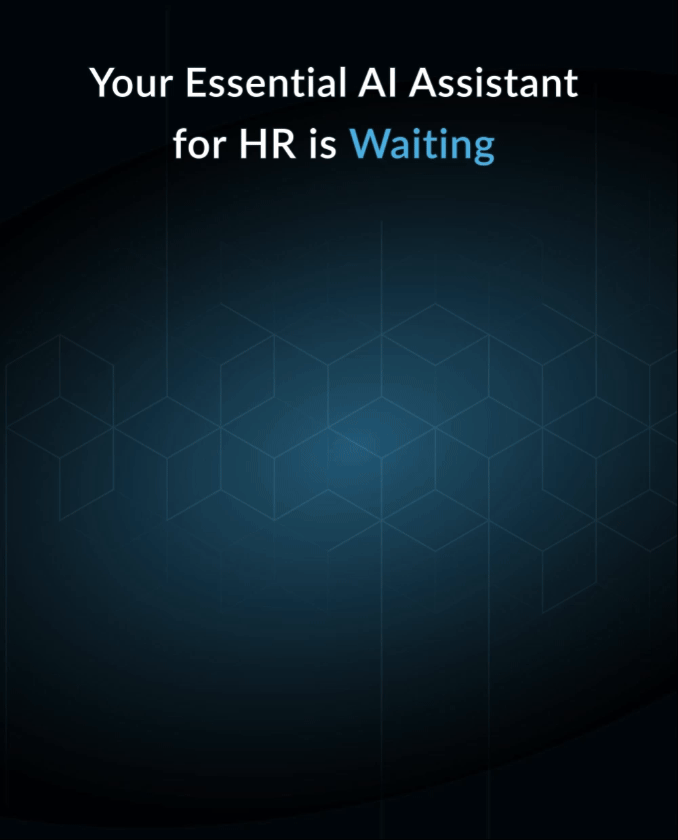Redesigning HR: An Operating System, Not An Operating Model.
It’s time for a new operating model for Human Resources, one we name “Systemic HR.” Bear with me as I explain this important change.
Business Challenge #1: Slower Growth, Labor Shortage
2023 represents a pivotal year. As we exit the pandemic and 15 years of low interest rates, companies are looking for new pathways to growth while they deal with inflation, hybrid work, and a long term labor shortage.
Consider the data: despite a slowing economy we have record low unemployment (3.4%), more than 11 million jobs open, (a 2:1 ratio of jobs to job seekers) and a further demand for labor as $49 billion from the CHIPS and Infrastructure bills creates more than 900,000 new jobs in manufacturing and construction.
And this appears to be a long-term issue. The global fertility rate has plummeted, baby boomers are retiring, and only about 62.4% of eligible workers are employed. To make it worse, today 36% of the US workforce is contingent which means they can leave their job at any time.
Clients tell us this is the new reality. Gallup’s global employee engagement is at a ten year low, dropping from 36% engaged in 2020 to 34% in 2021 to 32% in 2022. In response, companies like Home Depot just decided to invest an additional $1 Billion in pay for its store employees. (Starbucks and others are doing the same.) Almost every company we talk with has a focus on employee experience, reskilling, retention, and fair pay.
Business Challenge #2: Accelerated Industry Transformation
But it’s even trickier than you think: despite the layoffs we read about, most companies are still growing. And coming out of the pandemic the pace of change has quickened.
The new PWC CEO survey (2000 execs) found that 40% of CEOs believe “the company as it exists today will not be in business ten years from now.” And almost 60% of them said “I should be spending more time on Transformation than on Execution.”
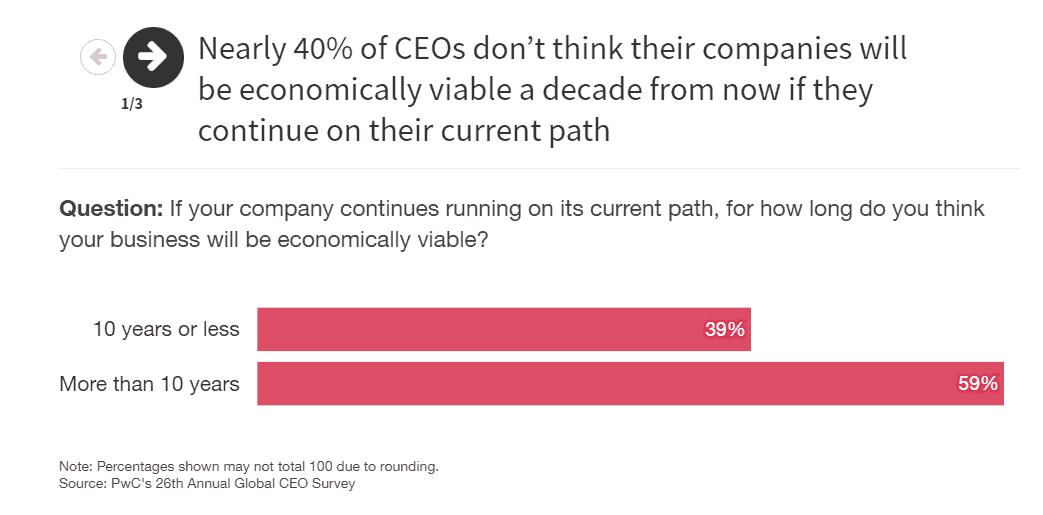 |
We saw this happening over a year ago and started an entire research program (The Global Workforce Intelligence Project) to study this effect. And what we’ve discovered will surprise you: in every industry we’ve studied (healthcare, consumer banking, consumer goods, pharma) we found a small number of “Pacesetter” companies who are way ahead in developing new skills, technologies, and business models. These transformation-centered companies are not only more profitable and better positioned, they are accelerating their lead on their peers. It’s speed of transformation, not quality of execution, that sets the pace ahead.
(Corporate Members can read all about these companies and their industry transformations.)
Learning From The Industry Pacesetters
How do these Pacesetters adapt?
First, they are filled with “transformation-ready” skills (culture of accountability, change agility, technology, talent mobility, skills-based rewards, productivity-focused design). Second, they embrace and invest in their people: they train people, actively move them from role to role, and they support their move from “slow growth” to “high growth” areas. Third, and most important to Systemic HR, they look at all organizational changes in an integrated, systemic way.
Consider a tech company that suddenly has too many people (ie. Salesforce). Rather than “hire to grow” they would have been steadily building better sales and go to market teams, re-engineering along the way. They look at all organizational growth strategies as a combination of “recruit, retain, reskill, and redesign,” continuously building better teams focused on new and evolved business models.
Ford’s decision to split off its EV business is a wonderful example. Rather than take an entire company focused on internal combustion engine machines and force-fit battery, motor, and digital technology into the mix, they split off the new business and redesigned the operating model for the new business. The new business is measured on growth: the old one is measured on profit, creating a whole new set of people practices.
(Here is an overview of our Org Design research, highlighted in the Org Design Superclass available to Corporate Members.)
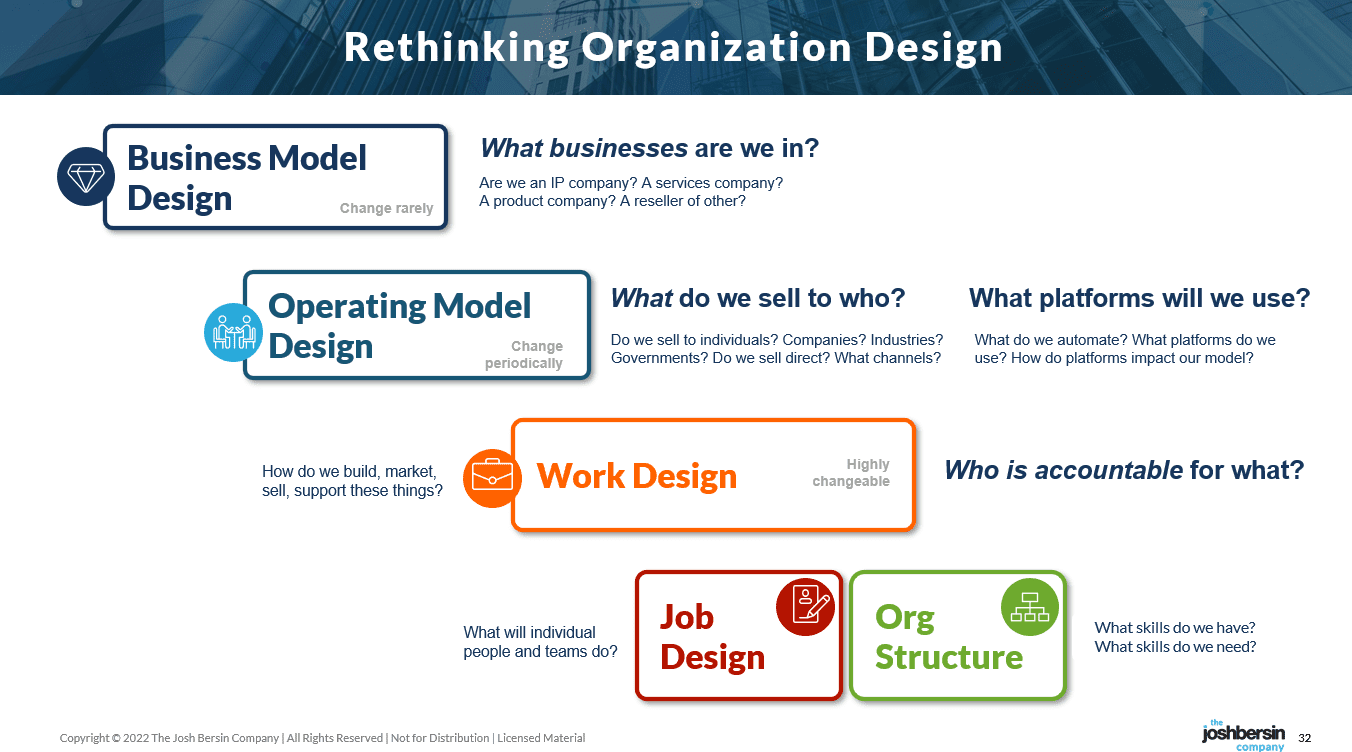 |
What does this mean for leaders? It means that HR-centric people strategies (recruiting, retention, development, pay, goal setting, and management) should be integrated together in a systemic way, creating total talent strategies, not just independently optimized recruitment, training, DEI, or pay programs.
As we learned how these companies thrive, we realized they manage HR as an “integrated operating system,” not a series of Centers of Excellence and Service Delivery teams. We call this new model Systemic HR – and it’s an Operating System, not an Operating Model.
An Operating System, Not An Operating Model
What’s the difference?
As we discovered in our new Organization Design research, the key to a fast-moving organization is not to “set rules” and create “operating standards.” It’s a problem of creating a set of shared culture, values, and priorities. It’s also about assigning accountability, developing relationships between people, and motivating people to help each other solve problems. And as I describe in my book Irresistible, it requires an organization that operates without focus on job title, job level, or politics.
And as our research points out, accountability does not mean each person has their own goals. It means we have a set of agreed-upon projects and priorities and we operate with purpose, clarity, and peer feedback.
Microsoft, a company that is executing extremely well, tells leaders that their number one job is to “create clarity” so people know where to focus. Then they “generate energy” through enthusiasm and purpose, and finally they “drive success” through iteration and productive work. These are the core fundamentals of success, not the “organization structure” you draw on a whiteboard.
HR, in its traditional form, was not designed this way. We mostly adopted a 1980s HR Service Delivery Model designed to minimize cost and cluster specialists into separate groups. (The Recruitment Team, the Training and Development Team, the Compensation and Benefits Team, and so on.)
It’s time to stitch this all together: HR should systemically focus on “problems” not “programs.”
Systemic HR Is Totally Interconnected
When I think about the companies we talk with and the challenges they face (improve healthcare delivery with a lack of clinical staff, build EV’s from a carbon-centric engineering team, create digitally-enabled insurance offerings, scale up a new chemical plant in a new area of science, redesign consumer supply chain for faster time to market), they require new job titles, new skills, and new ways of working. Can you just “hire these skills” on the open market? Of course not. We have to take a systemic approach.
Consider the 4R Model we developed during our healthcare research. Every problem of skills or scale is one of bringing these four elements together, not delegating them to “talent acquisition” to address.
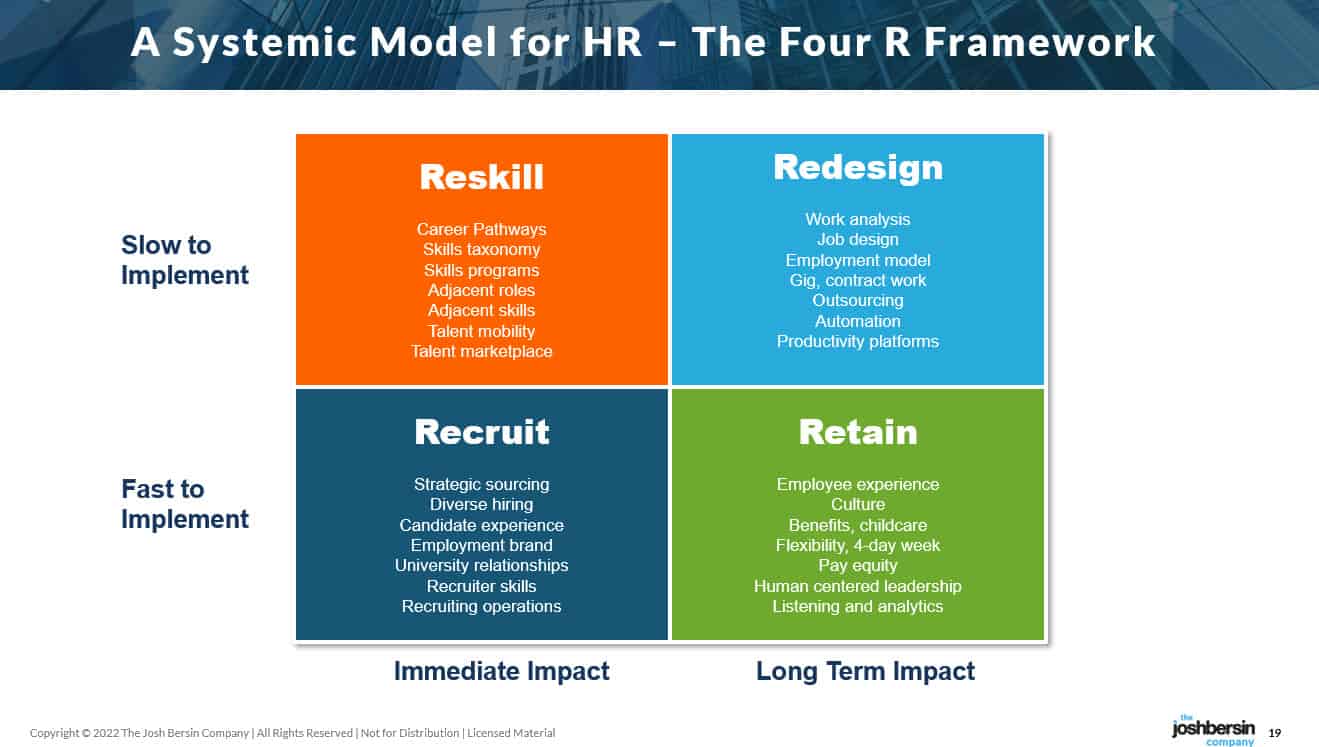 |
Suppose, for example, that your sales organization is underperforming. Is this a problem of leadership? Management? Hiring the wrong people? Sales training? Or maybe are they organized incorrectly and they need new territories or accounts? Or could they be underpaid or overpaid? Or could they feel disconnected from the company strategy? Or maybe the reward system has created a lack of teamwork?
The real problems we face in HR are all systemic. They cannot be solved by one HR domain alone.
Why then do we organize our HR organizations into Centers of Expertise (COE) and specialties?
The traditional (and long-discussed) structure of HR is that of a “Service Delivery” organization. (I think it’s modeled after old-fashioned IT departments.)
We have COEs in recruiting, training, talent management, compensation, diversity, analytics, and now employee experience. We buy and build technology systems to improve self-service and make employee HR needs easy to resolve. And now with AI and Chatbots, we’ll automate it even more.
But the real solutions and opportunities we go after are more complex. None of these COEs alone can truly solve the problem. Even recruiting, which has been blamed for over-hiring during the tech boom, is now expected to help with internal talent mobility, skills-based hiring, diverse candidate selection, and advice on pay. In other words, everything in HR is now interconnected.
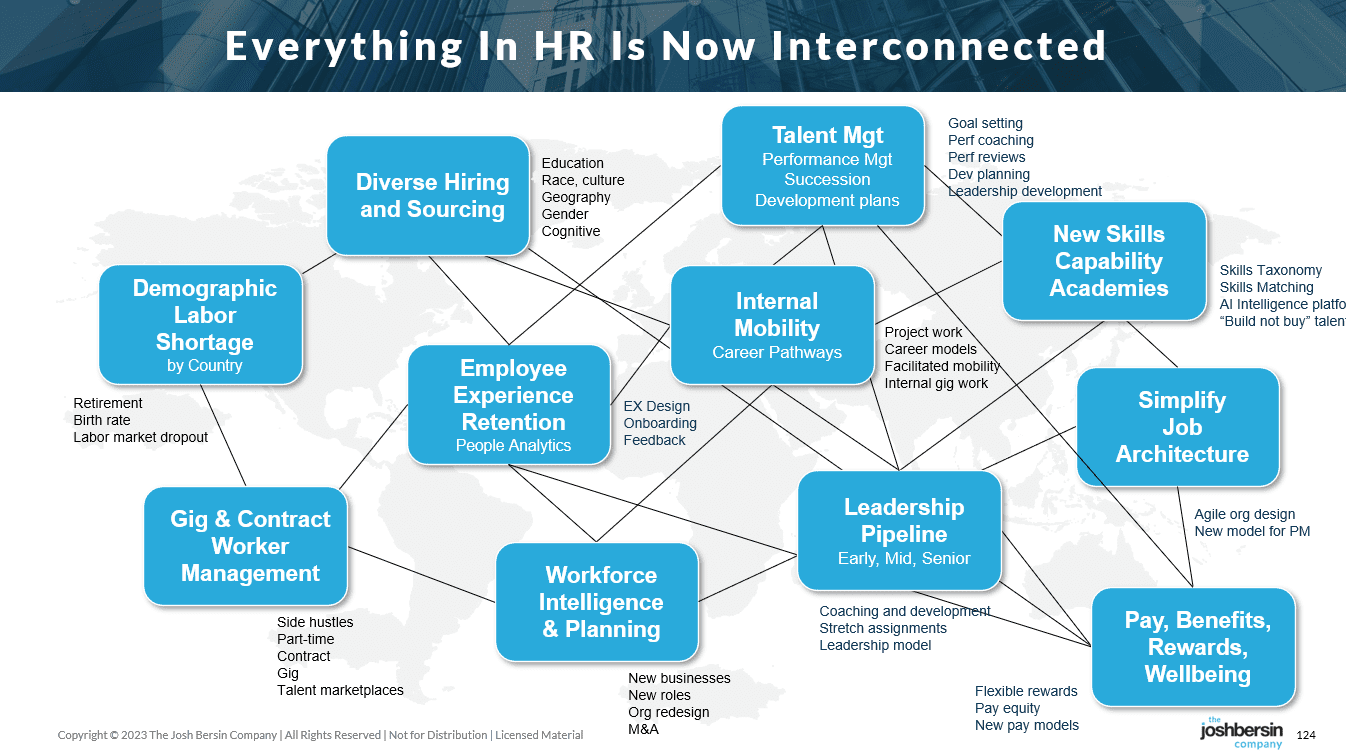 |
As we talk with HR teams in many large companies, I realized we are ready for a major change. HR departments don’t just need to be more “agile” or add product managers, design thinking, and iterative design to the profession. We need to rethink HR as a “system,” not a set of “services” or “offerings,” and we need to interconnect them together in a solution-oriented, real-time way.
Let me give you a great example. Six years ago Bank of America faced high turnover and lots of training and quality challenges in its massive retail operations. A senior business leader worked with the HR team to analyze the problem and discovered that hiring was done remotely, many of the onboarding and training programs were disconnected, and there was no monitoring or single service center to handle all the onboarding and development. He discovered that each individual in retail was going through a multi-year journey as they joined the bank, yet most of the programs were disconnected and much depended on the local management to deliver.
He and the senior HR team came up with a new “solution center” (that’s what I call it) which is now called The Academy at Bank of America. It consists of a new cohort-based hiring process, a tenure-based onboarding and development program that is delivered in phases, a special set of surveys and call center support teams to support and facilitate growth, and a whole set of integrated programs and metrics to drive skills, management development, and feedback in the retail teams.
It was so successful (case study here) that this approach has now been rolled out to the entire bank.
This is not a giant L&D program: it’s an integrated “solution center” designed to address growth, development, retention, and management skills in consumer operations. You can call it a Capability Academy or a Solution Center. The bottom line is that it is a “systemic solution,” one that integrates all the domains of HR into one, meaningful operation.
And in today’s economy this change has become urgent. Standalone HR COEs no longer deliver. And the goals and measurement of HR must change as well.
We are not a function that should be measured by “cost of HR per employee” or “speed of service delivery.” Those are important drivers but today HR is much more. We are asked to help the company transform, reduce risk, and grow. And that means we have to operate like an integrated “operating system,” working together to deliver solutions to each workforce segment. The HR staff must be cross-trained; we need far more integrated teams and operating models; and we need real-time data so we can adapt.
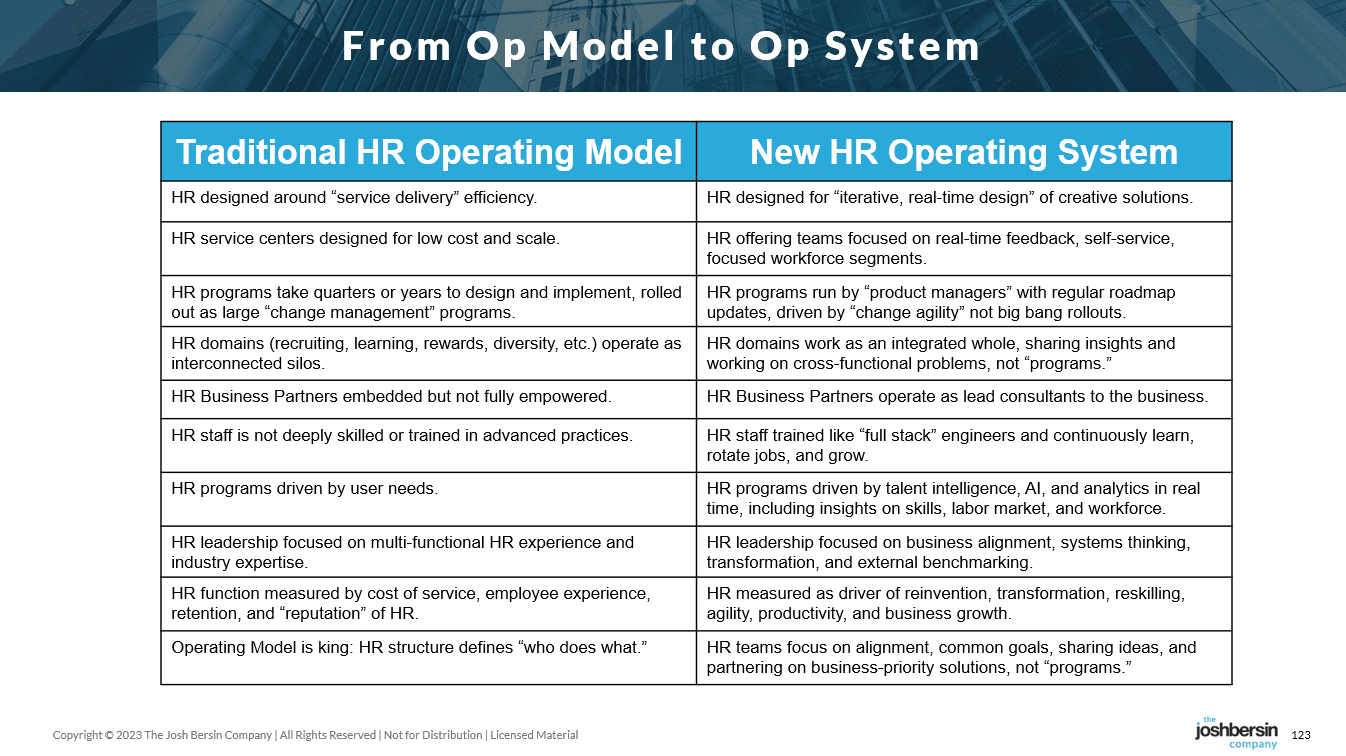 |
This is one of our biggest research projects of 2023: to document, detail, and explain this new world. And to give you a sense of what’s involved, here are just a few of the issues:
- We need “full stack” HR professionals (like full-stack engineers) who are deep in one domain but also have wide expertise in the other domains of HR. This means job rotation, professional development, and much more “solution orientation” to various talent problems. Check out our Global HR Capability Project or join the Josh Bersin Academy to benchmark your individual or team’s skills.
- We need “product managers” or “offering managers” who work together. The DEI offerings and product roadmap should be integrated with the roadmap for recruiting, performance management, and pay. We can’t just create standalone “HR programs” and roll them out with some hope they’ll succeed. If they aren’t all stitched together they never get synergy and momentum. So like an enterprise software company, we need all the HR disciplines to interconnect.
- We need HR professionals to focus on “problems” not just “programs.” And each HR professional should understand the people issues across the company, so they can contribute, help, or give feedback based on their local area. In a sense, HR is becoming a “professional services” function, not a “service delivery” team.
- We need easy to find, integrated, real-time data, so individual HR teams can easily agree on trends and areas of focus. This means investing in Talent Intelligence as well as people analytics.
- We need “solution centers,” “pods,” or other structures that organize HR teams into various workforce segments, functional groups, or problem areas – bringing HR disciplines together to address issues. (a’la Bank of America.)
- We need senior Business Partners who are both leaders and strategic advisors to their business counterparts, with power, authority, and expertise to bring agile HR consulting teams to bear.
- We need an HR leadership team that sees itself as a cohesive unit focused on advancing and innovating in the company’s strategic direction, turnaround, or business challenges.
I am reminded of the stories about tech companies “over-hiring” during the boom, and now have “too many people” and want to tweak the performance management process to weed out low performers. If we, as HR leaders, were thinking about the rampant hiring and weak onboarding over the last few years, maybe we could have pushed back a little and prevented some of this overshooting?
The reason that didn’t happen is that the Talent Acquisition function was isolated, “taking orders.” Recruiters were told their job is to “deliver a candidate as fast and as cheaply as possible,” reinforcing the growth mania. I’m not saying HR teams don’t have to take orders, but if we were operating systemically we may have seen the productivity slowdown and told leadership that “maybe we shouldn’t be hiring so fast?”
And our Global Workforce Intelligence research is flashing red. Healthcare, Banking, and Consumer Product companies are getting more systemic every day. This topic, as complex as it seems, is really the “next big thing” in HR, and that means it can impact every role in business.
How Can You Get Involved
First, we’ve just published a brand new course in the Josh Bersin Academy called Accelerating Your HR Career. I recommend you join the JBA, participate in the Global Capability Assessment, and get familiar with this journey.
Second, join us on this journey. If you and your senior HR team would like to participate in an interview, please register here for more information. We will set up a call and we welcome your participation.
Join us on the road to Systemic HR!
Additional Information
Predictions for 2023: Redefining Work, The Workforce, And HR
Were All These Layoffs Inevitable? Perhaps, But Here’s How It Happened.
Understanding Chat-GPT, And Why It’s Even Bigger Than You Think (*updated)
Join The Josh Bersin Academy: The World’s Home For HR
